Wednesday, September 10,2025. Annette’s Roundup for Democracy.
More about Trump’s friend and those who celebrated him and those who enabled him.
Warning. These 3 articles are shocking. Child rapists at play are supported.
Hopefully all men who hold power are not like this.
Article 1-In Epstein’s ‘Birthday Book,’ a Celebration of His Lecherous Exploits
The book containing 50th birthday tributes to Jeffrey Epstein was released on Monday by the House Oversight Committee.

Jeffrey Epstein photo in his birthday book.
One friend compared him to the main character in Ernest Hemingway’s “The Old Man and the Sea,” except instead of fish, Jeffrey Epstein caught women, “blonde, red or brunette.”
Another friend described a demeaning sexual encounter that a woman endured in the back of a car that left Mr. Epstein “howling with laughter.”
“So many girls, so little time,” wrote a third associate of Mr. Epstein.
Such tributes are part of the “birthday book,” which was dedicated to Mr. Epstein on his 50th birthday in 2003.
The 238-page book, littered with candid photos, drawings and collages, was released on Monday by the House Oversight Committee among the documents turned over by Mr. Epstein’s estate after being subpoenaed by the committee.
It offers a vivid portrait of how Mr. Epstein’s lewd and lecherous behavior with young women was both widely known and widely celebrated by people who described themselves as his closest friends and associates.
Compiled by his then-girlfriend Ghislaine Maxwell, the book contained everything from a handwritten letter from Mr. Epstein’s mother, to photos of scantily clad young women, to a cartoon drawing of Mr. Epstein lying in a beach chair getting what appears to be a nude massage from four topless women.
After an introduction by Ms. Maxwell, the book opens innocently with Mr. Epstein’s birth certificate and a letter from his mother, who wrote about his bar mitzvah and his being named one of Cosmopolitan magazine’s most eligible bachelors at the age of 27. There are report cards from his grade school and photos from his childhood.
But as the book continues, the submissions become crude and dark, containing numerous references to Mr. Epstein’s sexual conquests and female genitalia.
Most notably, the book contains the now well-publicized poem to Mr. Epstein that bears Donald J. Trump’s name. It is framed by a silhouette drawing of naked women and includes what appears to be Mr. Trump’s signature.
Elsewhere there is an oversized check that purports to be Mr. Epstein jokingly selling a “fully depreciated” woman to Mr. Trump for $22,500.
White House officials denied that Mr. Trump created the image of the naked woman.
But in keeping with the overall salacious tenor of the birthday book, that image and letter blend in.
The venture capitalist William Elkus described how Mr. Epstein managed to conjure a beautiful woman out of thin air during a visit to a farm town in Iowa, where it was hard to “tell the difference between the girls and the hogs.” Mr. Elkus mused that Mr. Epstein’s skill in finding a “spectacular tall blonde” whom he later invited back with him to New York suggested he had relied on “some long distance escort service.”
Mr. Elkus, reached by phone on Monday, said it was all meant to be a joke and said his note was a reference to Mr. Epstein's “charisma, which was palpable.”
Another person, named Leslie wrote, “I wanted to get you what you want,” so “here it is.” The brief, scrawled note is accompanied by a drawing of breasts. And another contributor, who said he “agonized long and hard about what to write,” added photos of zebras and lions having sex, adding that the images “seemed more appropriate than anything I could put in words.”
Many of the contributions are disturbing. In one letter, a person who signed only “Nick,” recounted an evening in London that left Mr. Epstein “howling with laughter.” That night, the contributor said, an “old man smiling sweetly” pulled down a woman’s panties and put his hand on her privates, only to find another man’s hand already there. Another letter alludes to when Mr. Epstein, in the mid-1970s, first “discovered the Maxwell teen-age daughter.”
Another poem ends noting that somehow at age 50, Mr. Epstein “has avoided the penitentiary.”
By his 55th birthday, Mr. Epstein would plead guilty in Florida to a state charge of soliciting prostitution from a teenage girl after securing a non-prosecution agreement from federal prosecutors. He would then spend nearly two years in jail and have to register as a sex offender.
But none of that stopped Mr. Epstein from beginning something of a second act in 2010, and the rich and famous continued to socialize with him — some almost right up until his arrest in July 2019 on federal sex-trafficking charges.
Ms. Maxwell, who compiled the book, is serving a 20-year prison sentence for conspiring to sexually traffic minors.
One submission attributed to former President Bill Clinton focused on what he described as Mr. Epstein’s “childlike curiosity” and his “drive to make a difference.”
A spokesman for Mr. Clinton has said the former president was unaware of Mr. Epstein’s crimes.
Other powerful people whose names are attached to tributes or mentioned in the book include the retail billionaire Leslie Wexner, the billionaire investor Leon Black, the attorney Alan Dershowitz and Jean Luc Brunel, a French modeling scout who died in 2022 by suicide in a French jail cell after being charged with raping teenage girls.
There are also letters from women — some of his assistants and girlfriends — who might have also been victims of Mr. Epstein. The names of the women are redacted.
One woman wrote: “With you, dear Jeffrey, I laugh like a little girl and feel like a woman.” The next page in the book simply shows a hand-drawn heart, a brief message and a photo of a woman’s buttocks in a thong bikini.
Another assistant described how Mr. Epstein transformed her life, from a 22-year-old woman who had been divorced and had worked in a hotel restaurant to a person who traveled the world meeting powerful people. Among them, she listed Mr. Trump, Mr. Clinton and “brilliant scientists, lawyers and business men.”
The book closes with a photo of Mr. Epstein lounging in a hammock on what appears to be Little Saint James in the U.S. Virgin Islands. The section ends with a brief note from Ms. Maxwell that reads: “The next fifty years will be even more wonderful.” (New York Times).
Article 2- Jeffrey Epstein’s Bankers.
If you haven’t read this 👆 shocking expose about Jeffrey Epstein’s bank, JP Morgan Chase, and the men who enabled him, you should.
It is a well-worth-your-time 25 minute read. Click here > Article 2- Jeffrey Epstein’s Bankers.
Article 3 - A Phony Trump Check and a ‘Depreciated’ Woman in Epstein’s Birthday Book
A photo in Jeffrey Epstein’s birthday book shows the disgraced financier holding a novelty check with a signature of “DJ TRUMP.” It includes a woman who dated both men in the 1990s.
The splashy focus of Jeffrey Epstein’s 50th birthday book released by lawmakers on Monday was a lewd drawing apparently signed by Donald J. Trump. But Mr. Trump’s cameo in another part of the book also provided fodder for Democrats and other critics of the president.
The entry, included in a bound volume in 2003, was made by Joel Pashcow, the former chairman of a real estate company in New York and a member of Mar-a-Lago, Mr. Trump’s resort in Palm Beach, Fla. It shows a photograph of Mr. Pashcow at the resort with Mr. Epstein, another man and a woman whose face is redacted. Mr. Pashcow is holding an oversize check that appears to have been doctored, with a seemingly phony “DJ TRUMP” signature.
A handwritten note under the photo, which was taken in the 1990s, joked that Mr. Epstein showed “early talents with money + women,” and had sold a “fully depreciated” woman to Mr. Trump for $22,500.
The woman, whose name is also redacted in the files released by the House Oversight Committee, was a European socialite then in her 20s, according to two people familiar with the original photo. She had briefly dated both Mr. Epstein and Mr. Trump around that time, according to court transcripts and a person close to Mr. Epstein. The birthday book entry appears to be a reference to the competition between the two men for the woman’s affections.
The nature of the woman’s relationship with Mr. Epstein is murky. The New York Times is not naming her because she may have been one of his victims.
A lawyer for the woman said she knew Mr. Epstein in “a professional capacity” when she was a student but severed ties with him in 1997. She did not know anything about the letter or its “derogatory content,” the lawyer added.
The House Oversight Committee, which had subpoenaed the estate, made the entry public along with the rest of the 238-page book. This included the sexually suggestive drawing that appeared to be signed by Mr. Trump, renewing the furor over the administration’s handling of the Epstein files.
Karoline Leavitt, the White House press secretary, said that Mr. Trump had not drawn or signed the picture and that he “absolutely” had not signed the oversize check in the photograph. Mr. Pashcow, 82, and his lawyer did not respond to requests for comment.
Democrats seized on the latest entry. In a post on X, the Democrats on the oversight committee announced the entry in all caps: “NEW PAGE FROM EPSTEIN’S BIRTHDAY BOOK.”
Mr. Pashcow appears to have contributed several consecutive pages to the book. On the page before the mock check is a vulgar cartoon depicting Mr. Epstein’s grooming of young girls: On one side, marked 1983, Mr. Epstein is handing out balloons to a group of girls; on the other, labeled 2003, he is receiving a naked massage from four topless young women. “What a great country!” it reads at the bottom.
The photograph with the giant check offers fresh insight on the social circles shared by Mr. Trump and Mr. Epstein. It is no secret that the two were friendly in the 1990s and early 2000s, before Mr. Epstein was convicted of sex crimes in 2008.
A visual analysis by The Times found that the photo was taken at Mar-a-Lago after the resort opened as a club in 1996 and was landscaped with palm trees and other features. In the background of the photo, a thatched hut is visible in front of a line of palm trees. The area is bordered by a white picket fence and what appears to be the white band of a tennis net is visible in front of the hut. The features match what was captured at the club by the renowned tennis photographer Art Seitz in February 1997.
The woman in the photograph was mentioned in the criminal trial of Ghislaine Maxwell, Mr. Epstein’s former girlfriend who is serving a 20-year prison sentence for conspiring to sexually traffic minors. An employee of Ms. Maxwell and Mr. Epstein testified that the pair “felt like a couple.”
Mr. Pashcow had many associations with the disgraced financier in the 1990s. His contact information appears in Mr. Epstein’s “black book” of people who were once in his social and business circles. And flight logs show that Mr. Pashcow flew on Mr. Epstein’s planes about 10 times between 1994 and 2001.
But his name has not come up in litigation brought by Mr. Epstein’s victims, said a lawyer who has represented numerous victims and a representative for another lawyer. (New York Times)
Live in New York City? Ready to vote!

Zohran Mamdani holds a strong lead in the race for New York City mayor, with remaining votes largely split between former Gov. Andrew Cuomo and incumbent Mayor Eric Adams, a New York Times/Siena College poll released Tuesday showed.
According to the survey, 46 percent of likely voters said they would vote for Mamdani, the Democratic nominee who rocked the party earlier this year when he handily won the mayoral primary against Cuomo, a longtime politician and bastion of New York politics.
contrast, 24 percent of voters said they would support the former governor. Cuomo announced his candidacy as an independent in the race for the city’s top spot after Mamdani clinched a decisive victory in the Democratic primary earlier this year.
Adams, who is also running as an independent, secured support from 9 percent of likely voters, while Republican candidate Curtis Sliwa garnered 15 percent support from respondents.
Jim Walden, an independent, received less than 1 percent support.
The survey was conducted as reports emerged that President Donald Trump was seeking to create a one-on-one matchup between Cuomo and Mamdani for the seat, saying that he didn’t want a “communist” mayor of the city, a dig at Mamdani’s progressive positions.
To that end, Trump has considered granting Adams a position as ambassador to Saudi Arabia, a move that would consolidate votes for Cuomo. Adams has also discussed moving into a position at the Department of Housing and Urban Development, in addition to other potential diplomatic posts in various other Persian Gulf states.
But the former mayor has maintained that he hasn’t been approached by the president for jobs in the administration and last week sloughed off suggestions that he was getting pressured to remove himself from the race.
A limited race between Mamdani and Cuomo would significantly narrow the Democratic nominee’s lead, Tuesday’s survey showed. Voters who backed Adams and Sliwa in a wider race overwhelmingly shifted their support to Cuomo in a hypothetical one-on-one with Mamdani, tapering his lead to 48 percent ahead of Cuomo’s 44 percent.
Mamdani’s primary success was largely owed to his successful campaign effort to hook into New Yorkers’ frustrations over the lack of affordability in the city.
According to Tuesday’s poll, Mamdani’s affordability messaging is still proving successful with voters. Forty-nine percent of likely voters said they thought the democratic socialist would perform the best on affordability issues, compared with 23 percent who said the same of Cuomo, 13 percent for Sliwa and 10 percent for Adams.
Similarly, 46 percent of voters expressed confidence in Mamdani’s ability to handle housing issues, compared with 24 percent for Cuomo, 16 percent for Sliwa and 11 percent for Adams.
Still, New York’s Democratic leadership — including House Minority Leader Hakeem Jeffries and Senate Minority Leader Chuck Schumer — have withheld endorsements from Mamdani, despite his overwhelming popularity among the party’s voters in the city.
The New York Times/Siena College poll was conducted from a pool of 1,284 likely voters in New York City from Sept. 2-6 and has a margin of error of plus or minus 3.6 percentage points. (Politico)
Trump’s economy is down, down, down.
I asked Google AI to summarize.
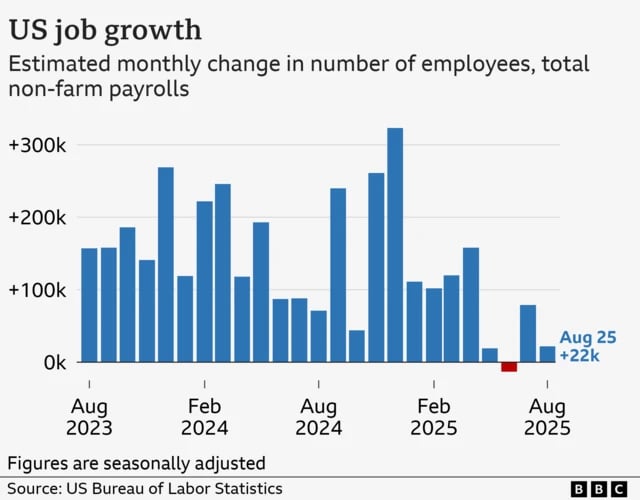
US economy adds fewer jobs than expected in August, confirming slowdown.
Job count lower. September 9
On September 9, 2025, the Bureau of Labor Statistics (BLS) announced a record-breaking preliminary benchmark revision showing the US economy created 911,000 fewer jobs in the year ending in March 2025 than initially reported. This means the labor market was weaker than previously estimated during that period.
This revision, along with recent reports of sluggish monthly job growth, is interpreted by many as a clear sign of a significant slowdown in the labor market.
Key findings from the latest jobs data
Massive downward revision: The preliminary annual revision downgraded the total job count by 911,000 jobs. The revision was based on more comprehensive data, suggesting that initial monthly payroll surveys overestimated job creation.
Weak August hiring: The August 2025 jobs report, released on September 5, 2025, indicated a significant slowdown in hiring. The economy added only 22,000 nonfarm payroll jobs for the month, well below expectations.
Rising unemployment: In August, the unemployment rate increased slightly to 4.3%, the highest it has been since 2021.
June job losses: Data revisions also showed that the economy lost 13,000 jobs in June 2025—the first monthly job loss since December 2020. This officially ended a 53-month streak of consecutive job growth.
Why the job numbers are lower
There are several contributing factors behind the lower job counts and softening labor market conditions:
- Slower hiring: With economic uncertainty and fluctuating trade policies, many employers have become more cautious about hiring.
- Negative economic signals: The labor market was slowing even before the negative revision, as indicated by a weak August jobs report and a downturn in consumer spending.
- Policy impacts: Economists point to former President Trump's tariffs and an immigration crackdown as potential headwinds for hiring in some sectors.
Revision methodology: The BLS uses a routine annual process to benchmark its monthly survey data against more complete state unemployment tax records. Large revisions can happen if the initial survey sample becomes less representative, a potential issue during periods of major economic shifts like those seen in recent years.
Context and outlook
The downward revisions and recent job reports confirm that the U.S. labor market is weakening. The Federal Reserve, facing a clearly cooling economy, is under increased pressure to lower interest rates.
While some sectors like healthcare have seen modest gains, overall hiring has stalled, and workers are becoming more cautious about changing jobs.
America really isn’t liking Trump.
Did the folks in DC think they were at the US Open?
Trump booed as he enters Joe’s Seafood a block from the White House. pic.twitter.com/oGVWj0pPmp
— Jessica Sidman (@jsidman) September 9, 2025
Another Special Election. Another victory.
We can take back the House in November.

Where does the Blue Team stand on shutting the Government to stop Trump?
House Democrats fume at Schumer in closed-door meeting.
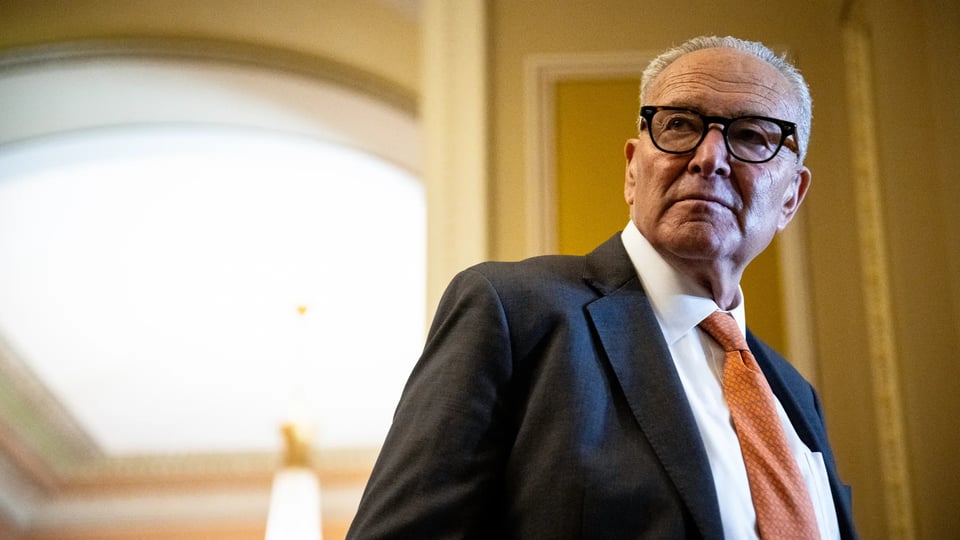
House Democrats' weekly caucus meeting Tuesday included a vent session towards Senate Minority Leader Chuck Schumer (D-N.Y.) on government funding, Axios has learned.
Why it matters: House Democrats still feel like Schumer betrayed them in March by supporting a Republican funding measure that they almost unanimously opposed — and they're worried he'll do it again.
"There was anticipatory anger rooted in what went down in March ... Schumer was named explicitly," one House Democrat told Axios on the condition of anonymity to offer details of the private meeting.
"The overriding concern was that Senate Democrats will get cold feet. Schumer can't sh*t the bed."
A spokesperson for Schumer did not respond to a request for comment.
State of play: The government is scheduled to shut down on Oct. 1 unless Congress passes a measure to extend federal funding.
Neither chamber is on track to pass all its annual appropriations bills by the end of the month, meaning Republican leaders will likely put a short-term funding measure called a continuing resolution up for a vote. Schumer and House Minority Leader Hakeem Jeffries (D-N.Y.) have signaled they want a reversal of some health care provisions in the Big, Beautiful Bill in exchange for Democratic votes.
What we're hearing: Some House Democrats aren't buying Schumer's resolve. "We don't want to get screwed again by the Senate," a second House Democrat who was in attendance told Axios.
A senior House Democrat said there was "mucho" anger in the meeting about Schumer and the Senate.
Several moderates, including Reps. Kim Schrier (D-Wash.), Jared Moskowitz (D-Fla.) and Brad Schneider (D-Ill.), stood up to express the views of their constituents that the party should put up a fight over government funding, according to several lawmakers.
"Lots of concern ... that we aren't sending a message that fights enough," is how a fourth House Democrat described the overall message (a Schneider spokesperson disputed that he criticized leadership).
Zoom in: Jeffries, for his part, told his members he is willing to reach a solution to the government funding impasse but not at the expense of Americans' health care, according to lawmakers and leadership sources.
Members broadly agreed that Democrats shouldn't give in without any of their demands being met, though there was debate about what that fight should look like and to what extent the party should go.
Specific health care-focused proposals, including extending Affordable Care Act subsidies and reversing Medicaid cuts in the Big, Beautiful Bill, have been floated as potential demands for the administration.
But some in the party want more profound checks on what they see as creeping authoritarianism and power consolidation by the Trump administration.
Between the lines: The Democratic base has been furiously exhorting their party's elected officials to take more of a scorched-earth approach to resisting the Trump administration.
Throughout the year, Democratic lawmakers have been harangued at events and in phone calls by grassroots supporters who say the party isn't fighting hard enough. The government funding deadline is effectively one of the party's only opportunities to exercise leverage over the Trump administration — though some in the party establishment fear the political fallout of forcing a shutdown.
Reality check: Any such concessions may cost more votes from Republicans than they gain from Democrats, making them a risky proposition.
Non-profit news outlet NOTUS reported Tuesday that some Republicans are already ruling out extending ACA subsidies — one of the least extreme proposals and one that even some GOP centrists support.
The bottom line: Asked Monday if he is worried about another Senate rug-pull, Jeffries told Axios that "House and Senate Democrats have been in close touch throughout this process and we will continue to meet in regularity."
"I know that they are communicating more, [Jeffries] has conveyed that to us," said the second House Democrat, "but I don't feel a level of confidence about anything right now." Schumer also faces something of a no-win situation in the government funding fight, the lawmaker argued: "I think no matter what happens, people come after Schumer [because] we need generational change." (Axios)
Whether you think that the Government should be shut down to stop Trump or you don’t, call your Senators and make a special call to Chuck Schumer. (202) 224-3121.
Yes, that Abigail Adams. Who knew.
Meet Abigail Adams, the Warren Buffett of Revolutionary America
The wife of John Adams, she was known for her financial acumen, her business initiative and her willingness to take risks.
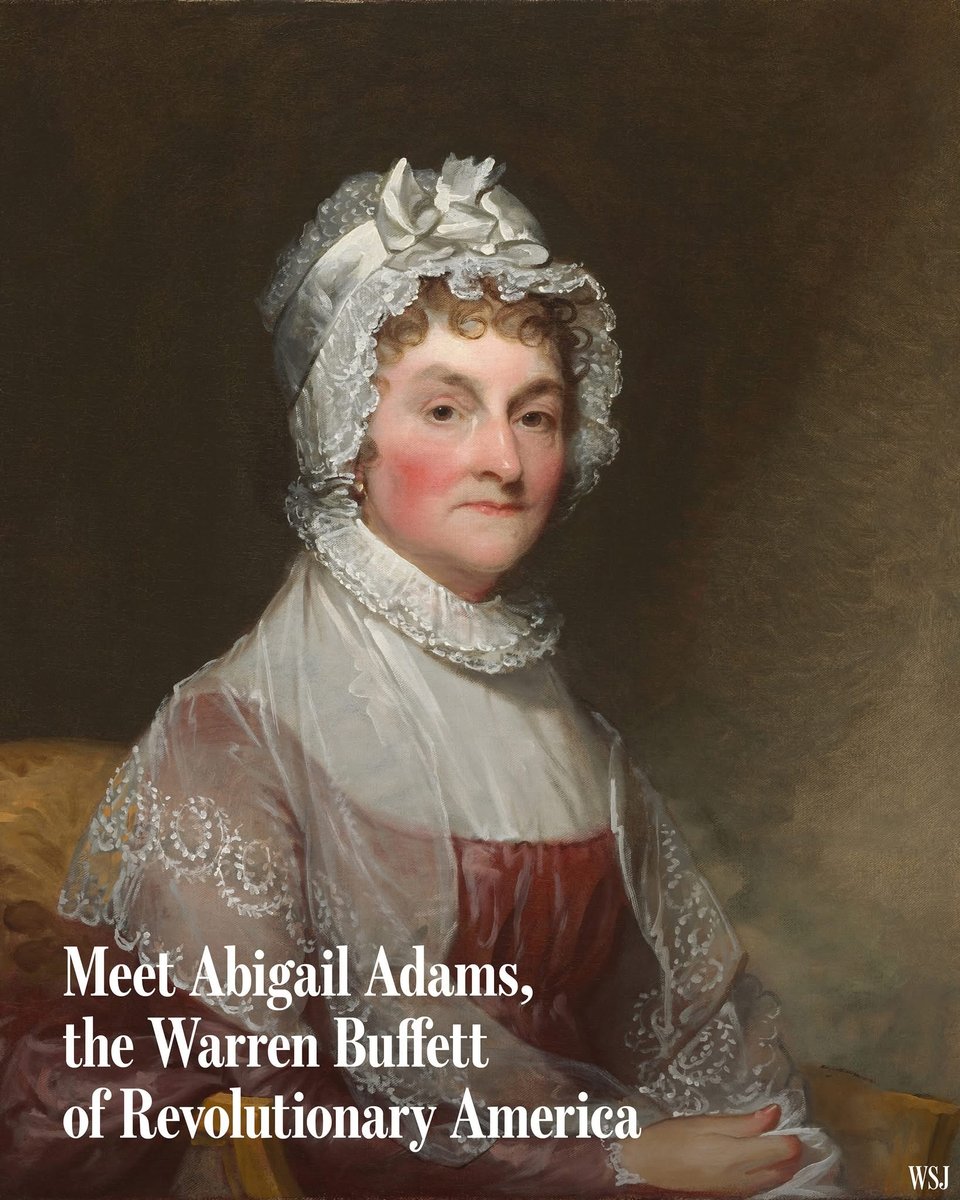
Her skills certainly didn’t go unnoticed in her time. Thomas Jefferson, for one, saw her as exceptional in her grasp of business matters. He described her as one of the “most attentive and honourable economists” in a letter to James Madison, and he praised her financial acumen and her direction of the couple’s financial affairs while John Adams was stationed in Europe on behalf of the fledgling American government.
Building a business
Indeed, Jefferson could have used her help with his own finances. Although he was a member of Virginia’s aristocratic planter class, he notoriously died in significant debt. He overspent on home remodeling and luxuries, including exquisite furnishings, artworks and hundreds of bottles of fine wine he brought back from his stint in Paris as the American minister to France.
“The Story of the World’s Greatest Economy” is a yearlong WSJ series examining America’s first 250 years. Read more about it from Editor in Chief Emma Tucker.
Abigail Adams, on the other hand, was frugal by nature and upbringing. She and her husband appreciated the finer things in life, but they spent within their means. Although they were never wealthy—they would be considered middle-class in today’s terminology—they ended up comfortably off in their later years.
What wealth they had was amassed in no small part due to Abigail’s economic stewardship, initiative and willingness to take measured risks.
The years leading up to and during the war disrupted many normal patterns of domestic life, at times allowing women like Abigail to breach the barrier that had excluded them from the realm of commerce and politics.
Despite the challenges in those times of finding reliable labor and coping with rising inflation, Abigail ably managed the Adams farm in Braintree, Mass., for many years before renting it out to tenants. She also started a small but thriving wartime business selling neighbors luxury French fashion and household items sent to her from Europe by her husband. These items, popular with fashionable women in the Boston area, included fine handkerchiefs, gauze fabric, ribbons, decorative feathers and artificial flowers. She also offered prized Dutch lace.

Peacefield, including the Old House, in Quincy, Mass., home to four generations of the Adams family.
There were risks in this business. Ships carrying cargo were often captured by the British, and Abigail lost some items this way that she had planned to sell. Still, she felt the risks were worth it, because even with reduced inventory the scarcity of the luxury items meant they would command a high price. With her urging, despite John’s reservations, he continued to regularly ship her merchandise, and the business was profitable.
Profitable investments
Not only did the income that Abigail Adams brought in help to pay the family’s Massachusetts taxes and living expenses, it also gave her sufficient capital to make investments.
She became increasingly confident about her financial prowess, and she sometimes disagreed openly with John about how best to increase their wealth and keep their finances on firm footing. John, the more financially conservative of the two, favored acquiring land, while Abigail saw far better profit opportunities in depreciated government securities and war bonds.
There were risks here just as there were in her business. In the midst of the Revolution, there was a real possibility that state or federal securities ultimately would prove to be worthless. “Purchasing depreciated government bonds from private individuals on the open market would transform her into a full-scale securities speculator,” according to historian Woody Holton.
Abigail wasn’t an infallible investor, but for the most part her judgment was sound. For instance, in 1777 she bought a depreciated note issued by Massachusetts to help fund the war. It ultimately brought her a 24% return, astounding for the time. In the early 1790s, she converted some of her Massachusetts government bonds into new federal securities that appreciated quickly and earned her significant returns.
Asserting control
With her success in business and investing, Abigail would come to assert a rather radical notion at the time—that some of the money she had earned belonged to her exclusively. For instance, in a 1785 letter to an uncle, she asked him to purchase bonds for her and use the “money which I call mine.” That flew in the face of the laws of coverture at the time, which asserted that husbands wholly controlled their wives’ finances. She also used some of her personal money to provide gifts of food and money to impoverished local women.
Some have argued that Abigail was an early feminist, one who famously urged her husband John to “remember the ladies” in the design of the new American government. The truth is more nuanced. Throughout her adult life, she valued as primary her domestic roles as mother and wife and adhered to the notion of a family hierarchy with the husband at the helm. At the same time, however, she exercised personal agency and was forward thinking in her support of robust education and legal and economic rights for women, helping carve a path for modern-day women.
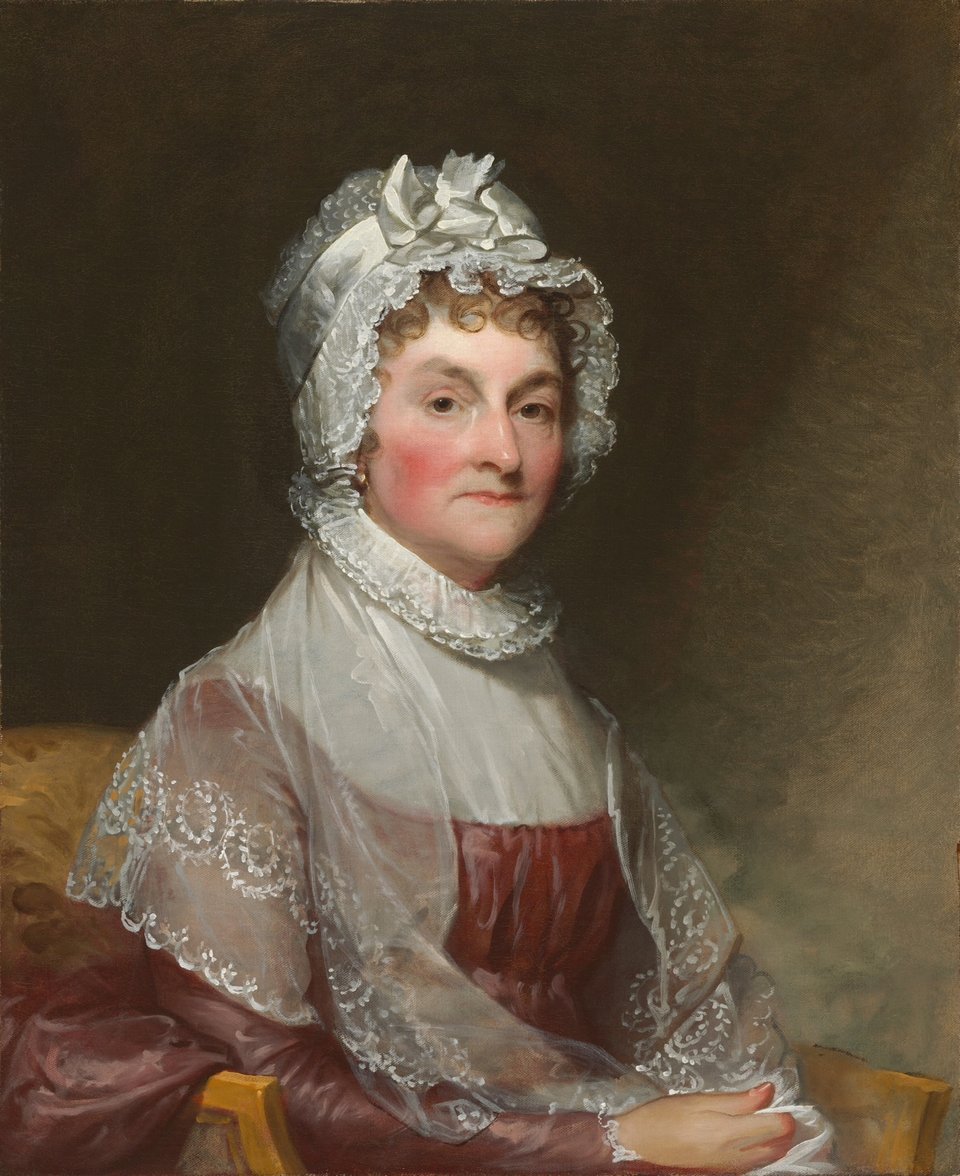
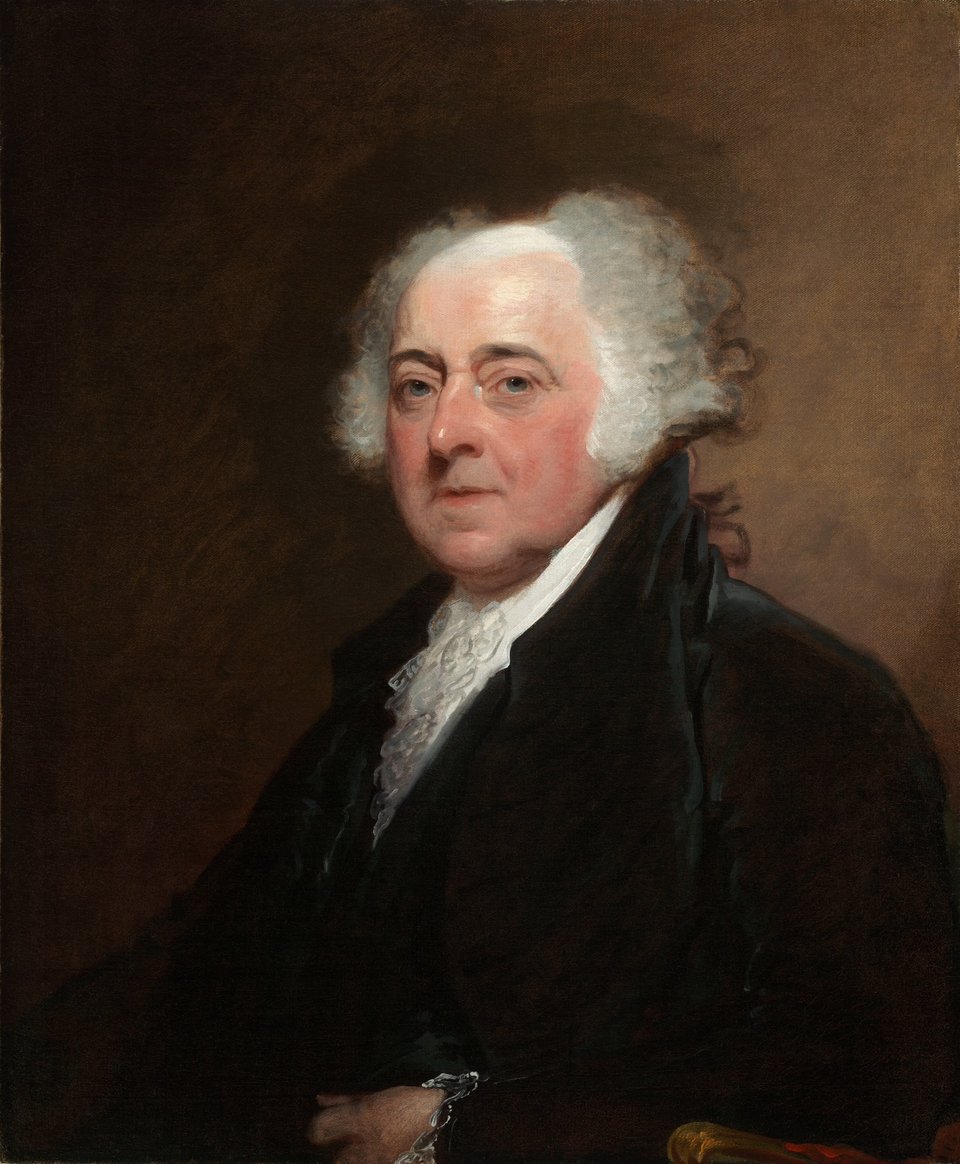
Portraits of Abigail and John Adams, both by painter Gilbert Stuart. NATIONAL GALLERY OF ART
She carried that independence and assertiveness through to the end of her life. Even though a personal will wasn’t considered a binding legal document in her time, Abigail— who died in 1818 at the age of 73—composed one in which she bequeathed her valuable possessions including jewelry, clothing, and even in some cases money and securities, to mostly female relatives. To John’s credit he honored her wishes.
Abigail’s strength earned her wide admiration in her day, as it does now. According to writer Judith Sargent Murray, an American female intellectual of their era, Abigail became so respected by some highly placed men in Boston that they declared that if John Adams were to die while serving as president, “they should rather see Mrs. Adams in the Presidential chair, rather than any other character now existing in America.”
If Abigail Adams had lived in our times, who knows? She might have become our nation’s first woman president—or just the chair of the Federal Reserve. (Wall Street Journal)